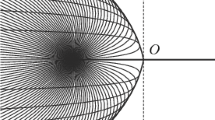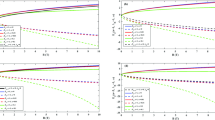Abstract
Darboux transformation is a powerful tool for the construction of new solvable models in quantum mechanics. In this article, we discuss its use in the context of physical systems described by \(4\times 4\) Dirac Hamiltonians. The general framework provides limited control over the resulting energy operator, so that it can fail to have the required physical interpretation. We show that this problem can be circumvented with the reducible Darboux transformation that can preserve the required form of physical interactions by construction. To demonstrate it explicitly, we focus on distortion scattering and spin-orbit interaction of Dirac fermions in graphene. We use the reducible Darboux transformation to construct exactly solvable models of these systems where backscattering is absent, i.e., the models are reflectionless.





Similar content being viewed by others
Data availability
Data sharing not applicable to this article as no datasets were generated or analyzed during the current study.
Notes
By \(2\times 2\) operator, we denote an operator acting on \({\mathbb {C}}^{2\times 2}\otimes {\mathcal {H}}\) where \({\mathcal {H}}\) is a Hilbert space.
Strictly speaking, the intertwining operator should write \({\mathcal {L}}={\mathbb {I}}_{m\times m}\partial _{x}-U_{x}U^{-1}\) with \({\mathbb {I}}_{m\times m}\) the identity matrix of dimension m. Nevertheless, for simplicity, we dropout the identity matrix form the notation.
This choice provides more compact formulas. It is also easier to discuss invertibility of the matrix U.
This condition is sufficient but not necessary. Numerical analysis confirms that there is a wide range of parameters where the condition is not satisfied but \({\mathcal {D}}(x)\) is still node-less. A similar condition could be found for \(w<v\), \({\mathrm{Im}}\,a<0\) and \(\epsilon _1,\epsilon _2\in (w,v)\).
\({\mathcal {L}}\) annihilates the two eigenstates from the interior of the energy band.
It depends on the actual values of \(\epsilon _j\), \(j=1,2,3,4,\) see discussion below (62).
References
P. Dirac, The quantum theory of the electron. Proc. R. Soc. Lond. A 117, 610 (1928)
J.D. Bjorken, S.D. Drell, Relativistic Quantum Mechanics (McGraw-Hill, New York, 1964)
W. Greiner, Relativistic Quantum Mechanics. Wave Equation, 3rd edn. (Springer-Verlag, Heidelberg, 2000)
I. Bialynicky-Birula, On the wave function of the photon. Acta Phys. Pol. 86, 97 (1994)
S.M. Barnett, Optical Dirac equation. New. J. Phys. 16, 093008 (2014)
S.A.R. Horsley, Topology and the Dirac equation. Phys. Rev. A 98, 043837 (2018)
S. Longhi, Supersymmetric Bragg gratings. J. Opt. 17, 045803 (2015)
F. Correa, V. Jakubský, Confluent Crum-Darboux transformations in Dirac Hamiltonians with PT-symmetric Bragg gratings. Phys. Rev. A 95, 033807 (2017)
H. Koizumi, S. Sugano, The geometric phase in two electronic level systems. J. Chem. Phys. 101, 4903 (1994)
L. Lu, J.D. Joannopoulos, M. Soljačić, Topological photonics. Nat. Photonics 8, 821 (2014)
S. Longhi, Non-Hermitian topological phase transitions in superlattices and the optical Dirac equation. Opt. Lett. 46, 4470 (2021)
A.H. Castro Neto, F. Guinea, N.M.R. Peres, K.S. Novoselov, A.K. Geim, The electronic properties of graphene. Rev. Mod. Phys. 81, 109 (2009)
E. McCann, V.I. Fal’ko, Landau-level degeneracy and quantum hall effect in a Graphite Bilayer. Phys. Rev. Lett. 96, 086805 (2006)
E. McCann, M. Koshino, The electronic properties of bilayer graphene. Rep. Prog. Phys. 76, 056503 (2013)
M. Castillo-Celeita, V. Jakubský, Reduction scheme for coupled Dirac systems, J. Phys. A 54, 455301 (2021)
L.H. Haddad, L.D. Carr, Relativistic linear stability equations for the nonlinear Dirac equation in Bose-Einstein condensates. EPL 94, 56002 (2011)
E. Sadurní, T. Seligman, F. Mortessagne, Playing relativistic billiards beyond graphene. New J. Phys. 12, 053014 (2010)
J.A. Franco-Villafañe, E. Sadurní, S. Barkhofen, U. Kuhl, F. Mortessagne, T.H. Seligman, First experimental realization of the Dirac Oscillator. Phys. Rev. Lett. 111, 170405 (2013)
F. Cooper, A. Khare, U. Sukhatme, Supersymmetry in Quantum Mechanics (World Scientific, Singapore, 2001)
G. Junker, Supersymmetric Methods in Quantum and Statistical Physics (Springer, Berlin, 1996)
G. Junker, Supersymmetric Dirac Hamiltonians in (1+1) dimensions revisited. Eur. Phys. J. Plus 135, 464 (2020)
Ş Kuru, J. Negro, L.-M. Nieto, Exact analytic solutions for a Dirac electron moving in graphene under magnetic fields. J. Phys. Condens. Matter 21, 455305 (2009)
A. Contreras-Astorga, Solutions of the Dirac equation in a magnetic field and intertwining operators. SIGMA 8, 082 (2012)
A. Contreras-Astorga, A. Schulze-Halberg, The confluent supersymmetry algorithm for Dirac equations with pseudoscalar potentials. J. Math. Phys. 55, 103506 (2014)
B. Midya, D.J. Fernández, Dirac electron in graphene under supersymmetry generated magnetic fields. J. Phys. A 47, 285302 (2014)
Ö. Yeşiltaş, Supersymmetric analysis of the Dirac–Weyl operator within PT symmetry. J. Math. Phys. 55, 082106 (2014)
M. Castillo-Celeita, D.J. Fernández, Dirac electron in graphene with magnetic fields arising from first-order intertwining operators. J. Phys. A 53, 035302 (2020)
D.J. Fernández, J.D. García, D. O-Campa, Bilayer graphene in magnetic fields generated by supersymmetry. J. Phys. A 54, 245302 (2021)
L.-M. Nieto, A.A. Pecheritsin, B.F. Samsonov, Intertwining technique for the one-dimensional stationary Dirac equation. Ann. Phys. 305, 151 (2003)
A.A. Pecheritsyn, E.O. Pozdeeva, B.F. Samsonov, Darboux transformation of the nonstationary Dirac equation. Russ. Phys. J. 48, 365 (2005)
E. Pozdeeva, A. Schulze-Halberg, Darboux transformations for a generalized Dirac equation in two dimensions. J. Math. Phys. 51, 113501 (2010)
A. Schulze-Halberg, A. Ishkhanyan, Darboux partners of Heun-class potentials for the two-dimensional massless Dirac equation. Ann. Phys. 421, 168273 (2020)
V. Jakubský, L.-M. Nieto, M.S. Plyushchay, Klein tunneling in carbon nanostructures: a free-particle dynamics in disguise. Phys. Rev. D 83, 047702 (2011)
V. Jakubský, M.S. Plyushchay, Supersymmetric twisting of carbon nanotubes. Phys. Rev. D 85, 045035 (2012)
F. Correa, V. Jakubský, Twisted kinks, Dirac transparent systems and Darboux transformations. Phys. Rev. D 90, 125003 (2014)
N. Chandra, N.M. Litchinitser, Photonic bandgap engineering using second-order supersymmetry. Commun. Phys. 4, 59 (2021)
A. Altland, Low-energy theory of disordered graphene. Phys. Rev. Lett. 97, 236802 (2006)
E. McCann, K. Kechedzhi, V.I. Fal’Ko, H. Suzuura, T. Ando, B.L. Altshuler, Weak-localization magnetoresistance and valley symmetry in graphene. Phys. Rev. Lett. 97, 146805 (2006)
J.L. Mañes, F. Guinea, M.A.H. Vozmediano, Existence and topological stability of Fermi points in multilayered graphene. Phys. Rev. B 75, 155424 (2007)
A. Avsar, H. Ochoa, F. Guinea, B. Özyilmaz, B.J. van Wees, I.J. Vera-Marun, Colloquium: spintronics in graphene and other two-dimensional materials. Rev. Mod. Phys. 92, 021003 (2020)
C.L. Kane, E.J. Mele, Quantum spin hall effect in graphene. Phys. Rev. Lett. 95, 226801 (2005)
D. Huertas-Hernando, F. Guinea, A. Brataas, Spin-orbit coupling in curved graphene, fullerenes, nanotubes, and nanotube caps. Phys. Rev. B 74, 155426 (2006)
E. Díaz-Bautista, D.J. Fernández, Graphene coherent states. Eur. Phys. J. Plus 132, 499 (2017)
David J. Fernández, D.I. Martíez-Moreno, Bilayer graphene coherent states. Eur. Phys. J. Plus 135, 739 (2020)
A. Schulze-Halberg, M. Ojel, Darboux transformations for the massless Dirac equation with matrix potential: construction of zero-energy states. Eur. Phys. J. Plus 134, 49 (2019)
V. Jakubský, M. Tušek, Dispersionless wave packets in Dirac materials. Ann. Phys. 378, 171 (2017)
Marie Fialová, Vít. Jakubský, Matěj Tušek, Qualitative analysis of magnetic waveguides for two-dimensional Dirac fermions. Ann. Phys. 395, 219–237 (2018)
P. Ghosh, P. Roy, Bound states in graphene via Fermi velocity modulation. Eur. Phys. J. Plus 132, 32 (2017)
T. Ando, Impurity scattering in carbon nanotubes—Absence of back scattering. J. Phys. Soc. Jap. 67, 1704 (1998)
F.M. Fernández, Introduction to Perturbation Theory in Quantum Mechanics (CRC Press, Boca Raton, 2000)
W. Greiner, Quantum Mechanics, An Introduction, 4th edn. (Springer-Verlag, Berlin, 2001)
M. Reed, B. Simon, Methods of Modern Mathematical Physics (New York, IV, Analysis of Operators (Academic, 1978)
Acknowledgements
M.C.-C. thanks Department of Physics of the Nuclear Physics Institute of CAS for hospitality. M.C.-C. acknowledges the support of CONACYT, project FORDECYT-PRONACES/61533/2020. V.J. was supported by GACR grant no 19-07117S. K.Z. acknowledges the support from the project “Physicists on the move II” (KINEÓ II), Czech Republic, Grant No. CZ.02.2.69/0.0/0.0/18 053/0017163. The authors would like to thank the anonymous referee for constructive comments and suggestions.
Author information
Authors and Affiliations
Corresponding author
Appendix
Appendix
We shall find asymptotic form of the matrix \(U_xU^{-1}\), where U is given in (54). We have
where the matrix elements and the denominator are as follows:
and \({\mathcal {D}}(x)\) is given in (57). For the sake of completeness, we put the formula here again
The \(c_1\) and \(c_2\) constants are given as
Now, we calculate the limit \(x\rightarrow {{{\pm }}}\infty \) of the matrix \((\partial _xU)U^{-1}\),
where
Rights and permissions
About this article
Cite this article
Castillo-Celeita, M., Jakubský, V. & Zelaya, K. Form-preserving Darboux transformations for \(4\times 4\) Dirac equations. Eur. Phys. J. Plus 137, 389 (2022). https://doi.org/10.1140/epjp/s13360-022-02611-z
Received:
Accepted:
Published:
DOI: https://doi.org/10.1140/epjp/s13360-022-02611-z




